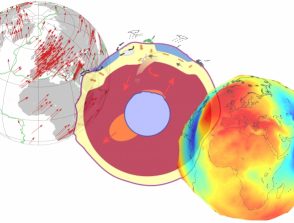Homogenization and trend estimation of GNSS water vapour observations and atmospheric reanalyses. Application to climate change analysis
Start: 01 October 2020
End: 08 December 2023
Supervisors :
Olivier Bock, Emilie Lebarbier
Related teams :
Geodesy
Status: Defended
Water vapour plays an important role in the Earth’s energy balance and hydrological cycle. As the climate warms, water vapour in the atmosphere tends to increase, but the geographical distribution of water vapour trends in climate model simulations and observations remains quite uncertain. Global Navigation Satellite System (GNSS) estimates of Integrated Water Vapor (IWV) are a new data source that may serve for the verification of observed and simulated water vapour trends. Previous studies have reported inhomogeneities in the GNSS IWV records due to changes in the station instrumentation and in data processing methods, and recommended their homogenization for climate applications.
Following modern approaches to climate data homogenization, this study uses a statistical segmentation method to detect abrupt changes, called change-points, in the mean (or jumps) of IWV differences series between GNSS and reanalysis data. Difference series are used to mitigate the strong temporal variability inherent in the IWV series which makes the detection of small jumps difficult on the raw series. This study employs the GNSSseg R package developed by Quarello (2020).
The first objective of this thesis was to investigate the sensitivity of the segmentation results and trend estimates to the input data properties. Two specific GNSS datasets were considered as inputs (IGS repro1 and CODE REPRO2015) and two different reanalysis products (ERA-Interim and ERA5). It is found that only 45-50% similar change-points are detected when the input data are altered. Altering the series length or the auxiliary data used in the processing of GNSS IWV data has a smaller impact, with 70-80% similar detections. Segmentation results are sensitive to the noise magnitude and the presence of a periodic bias in the input data, mainly due to representativeness differences between the GNSS observations and reanalysis. More recent GNSS and reanalysis products have smaller differences and allow the detection of smaller jumps. The subsequent trend estimates are sensitive to the number and position of change-points. Therefore, validation of detected change-points is a crucial step before trend estimation. It is found that changes in GNSS instrumentation available as metadata can explain 35% of change-points, leaving 65% as either undocumented GNSS changes or changes in the reanalysis data.
The second objective of this thesis was to develop an automatic classification method, operated as a post- processing step, to distinguish GNSS and reanalysis change-points. The proposed “attribution” method combines GNSS and reanalysis data from a main station with similar data from nearby stations. Each main-nearby pair comprises four base series from which six series of differences are formed. Then, for each detected change-point in the main series, a significance test is applied to the mean before and after the change-point, and a classifier or a statistical predictive rule is constructed to attribute the tested change-point to GNSS or reanalysis. When several nearby stations are available, a combined solution is proposed. The original aspect of the developed attribution method is the use of a generalized least-squares inference method, to account for heteroscedasticity and autocorrelation in the data, and a machine learning classifier. The main novelty is the way in which the predictive rule is constructed, using test results obtained from the real data with a resampling procedure. Sensitivity analysis shows that the prediction results depend somehow on the resampling strategy, using balanced or imbalanced samples, on the test significance level, and also on the magnitude of the noise in the data. A limiting factor in spare networks is the large noise with long distance between the main and nearby stations. When applied to the CODE REPRO2015 GNSS data and ERA5 reanalysis, 62% of the tested change-points are attributed to GNSS, 19% to the reanalysis, and 10% to changes in both GNSS and reanalysis.





